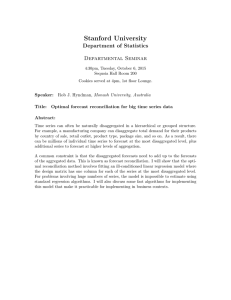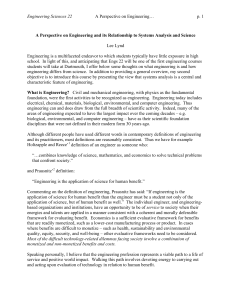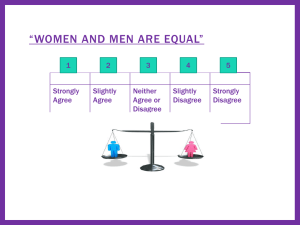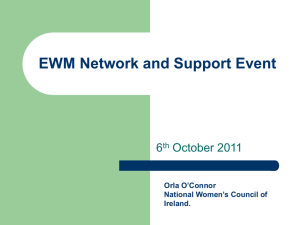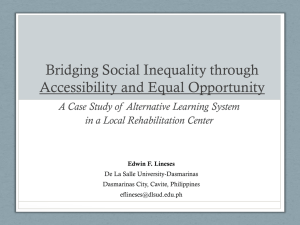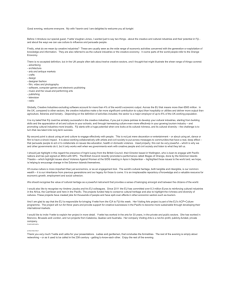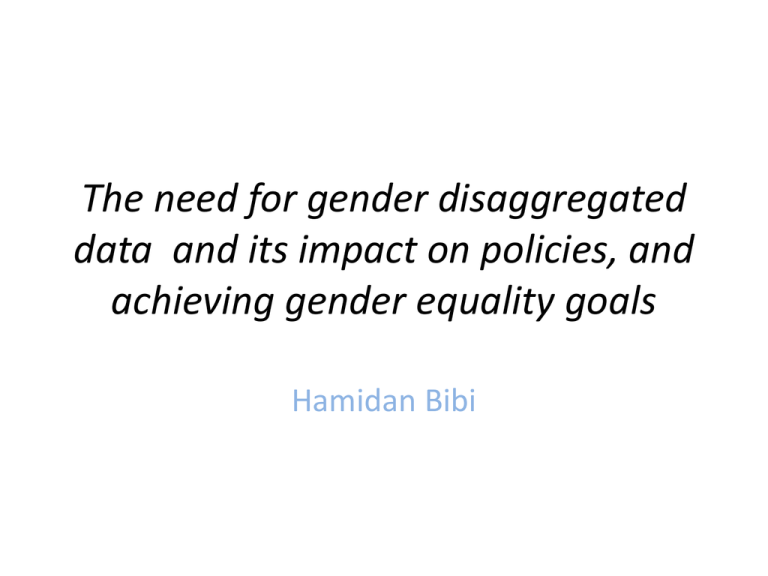
The need for gender disaggregated
data and its impact on policies, and
achieving gender equality goals
Hamidan Bibi
Introduction
Gender disaggregated data
• A useful monitoring avenue, gender
disaggregated data is the collection of
information from a sample group that includes
both male and female participation on the
different experiences, needs, interests and
access to opportunities and resources of men
and women so as to establish an accurate
picture of the local context. It can be both
quantitative and qualitative data.
LG roles...
• Community leader
• Provider and
administrator of
services
• Planner
• Regulator
• Major employer
• A key player in
important partnerships
Key Challenge
• Lack of and or
unavailability of
evidence-based data
• Lack of urgency toward
gathering and analysing
data
• Over reliance on
national data and
trends
• “There has been considerable progress in the
collection of data used to analyse progress
towards gender equality with several countries
having conducted Demographic and Health
Surveys (Nauru, PNG, Solomon Islands, RMI, and
Tuvalu) and Household Income Expenditure
Surveys (Fiji, FSM, Kiribati, PNG, Samoa, Solomon
Islands, Tonga, Tuvalu and Vanuatu) producing
much relevant data, there are still significant gaps
in data and analysis needed for comprehensively
tracking progress toward gender equality”.
• This situation reflects insufficient investment in and
accountability for gender responsive development.
• Policies, strategic and annual plans, targets and
indicators for which the data are collected too often
use gender neutral instead of gender specific language,
making it impossible to disaggregate the data by sex
and conduct gender analysis. In addition, although sexdisaggregated data is collected, authorities do not
usually report it and only through special enquiries are
these figures accessible,”. .. pg 49 .. 2013 Pac Regional
MGD tracking Report, PIFS
• “Whilst women comprised half of Fiji’s population,
stakeholders interested in the gender issues in
employment and unemployment were often limited in
their policy analysis because of the paucity of accurate
statistics specifically by sex”. ....
• “ Policies to encourage gender equality in any of these
areas (employment etc) require accurate data and
statistics which clearly outline the nature of gender
inequality and how the situation has changed over
time”... pg 5.. Gender issues in Employment,
Unemployment and Incomes in Fiji , 2007, Dr Wadan
Narsey
Benefits
• Meaningful and a good
practice that results in
more valid information
for planning
development
• Ensures policies are
more informed, specific
• Prompts thorough
examination of an issue
thus specific policies
Benefits
• Achieve better health
outcomes
• Helps identify and
redress inequity,
inequality and other
disadvantages
• Develop targeted
programs and policies
that assess and reduce
barriers and negative
impacts, and increases
participation
Benefits
• Can adequately and
effectively respond to
social and demographic
changes – front runner
for change
• Planned rather than a
reactionary approach
• Good basis for gender
responsive budgeting
and mainstreaming
Benefits
• Specialist skills
development
• On-going activity that
could attract donors,
and lead to good
practice or best practice
Key Barriers for LGs
• May not have trained personnel nor other
resources to undertake analysis and gathering
of gender disaggregated data
• Leadership not interested and not gendersensitized
Conclusion
It’s important to realise that accurate evidencebased data such as gender disaggregated data
would provide for the development of a more
informed and meaningful policies that are
specific and targeted, and essentially
supporting LG’s need to respond more
effectively to the many changes.
Conclusion
• By making it a
priority would
lead to a
competitive and
sustainable local
government,
which is more
liveable.
Tank u tru


